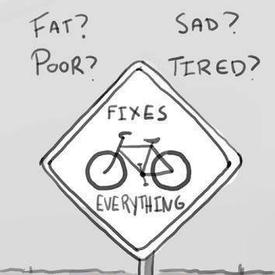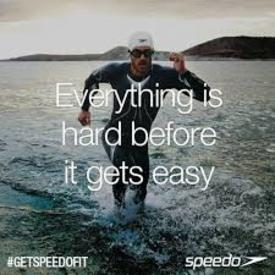Training problems

Hazelthecat11
Posts: 25 Member
Hello, I really want to do a sprint triathlon but I don't really have anywhere to train for the transitions. I can do each one individually but not in the right order and I have no open water to practice in. I live in southern Germany so I have great trails to bike and run on but my water access is limited to one pool that has odd operating hours. Any advice?
0
Replies
-
Honestly you can do it just about anywhere (driveway, parking lot, etc) that you can simulate racking your bike. If it's a wetsuit legal race just start out in the wetsuit with it pulled down to your waist as this is generally how you'll enter T1. Get to the bike and practice pulling off your suit, putting on the shoes (if not doing a flying mount), on with sunglasses, on with helmet, unrack bike and go. Coming back practice dismounting, racking bike, helmet off, shoes on, grab everything else and put it on while running. The lack of water really isn't that big of a deal IMO.0
-
Honestly, I didn't practice transitions too much before my sprints this summer. I would often go biking, leave my running shoes by my front door, and "transition" from the bike to run in my driveway, but that was it. I didn't ever practice the swim to bike transition because I swim in a pool, but all of my triathlons were open water. I think you will be fine.0
-
Unless you have intentions to win, don't worry about transitions. Just focus on finishing it. There is plenty of advice out there on how to speed up transitions, but ultimately you will just need to find out what works for you, and that only comes with time.0
-
Unless you have intentions to win, don't worry about transitions. Just focus on finishing it. There is plenty of advice out there on how to speed up transitions, but ultimately you will just need to find out what works for you, and that only comes with time.
This^^^
Your first time out the likelihood of you getting a podium spot are limited. Just plan to go out and have fun and learn what you can from your experience. Transitions times will improve with each race and will vary depending on distance. Meaning a Spring triathlon requires little more than throwing on shoes and going while a full Ironman requires a lot of planning and time preparing for a long time out on the course.0 -
For most people the T2 (bike to run transition) is the most difficult as your leg muscles have to reorient to work differently. In my first few triathlons I had real problems with leg muscle cramping when I started the run but after a couple hunderd meters they would typically clear up. So I would recommend doing a few run-bike brick workouts in your training to simulate that transition. That is the only aspect of transition that you probably should spend some time on. Don't worry about the clock on your first tri or how long your transition is, just take it in and enjoy the experience. If you like it and want to continue in the sport then you can start identifying ways to improve your time if that's one of your goals.
As far as your first open water swm goes, unless you are a strong swimmer start on the outside and back of the pack. Go out at a comfortable pace and don't worry about trying to stay up with anyone. One of the biggest mistakes new triathletes make is going out way too hard in the swim and then being wiped out for the other two legs. It is the shortest leg in total duration so there is little upside to working it hard and a big downside if you wipe yourself out. Save your real effort for the bike (the longest duration leg) and the run.0 -
I have a smiliar problem with having no open water to practice in. You want to make sure you practice sighting (looking where you're going) and breathing on one side and the other in case it's windy and the waves are trying to choke you on one side, you can easily do all that in a pool. As long as you do that you're fine. Transitions aren't important unless you're incredibly enthusiastic, as long as you can get your wetsuit off and your shoes/bike helmet on. I'm pretty sure I sat down and ate gels in one of my halfIMs in T2...0
-
Some great advice here. Relax, enjoy the race and learn from the inevitable mistakes which will be made (we've all done it!). However, practising transitions isn't too hard as long as you can get wet you don't need to have swam first. The T1 difficulties are less to do with having swam than just being wet, stripping wetsuit etc. T2, well that's the one well worth practising with brick sessions of bike then quick change and run. Ideally lay out your kit as you will at the race (small area) and change as fast as you will on race day to sort out the order of what to do. After it's all a bit automatic and if you fancy a bit of a challenge have your partner/friend/neighbour kick your stuff out of position to simulate a real transition!0
-
My transition advice would be to bring only what you absolutely need for racing into the transition area. When you're tired, even little things can be enormously distracting. I also repeat the mantra, "First head, then feet" so that I always switch out gear in the same order and don't do something stupid like take off running with my bike helmet on.0
-
^^^ I was at a particularly difficult race one day, and was wiped out by the time I hit T1. I put my helmet on my bike saddle, got everything else ready, and pulled my bike off the rack to get started, with the helmet still on my saddle. An astute (and very lenient) race official came running over to me yelling at the top of her lungs, "Your helmet isn't on! Your helmet isn't on! If a race official sees this, they're going to disqualify you!!!" (She WAS a race official!) I immediately threw my helmet on, grateful that I wasn't DQ'd for such a stupid lapse of reason in a time of brain-fry. Technically, she should have DQ'd me, instead of just yelling at me. Every time I look at the tattoo I got after that race, I think of her. She saved my race.
First triathlons are all about having fun. Lots and lots and lots of fun. Practicing transitions is a great idea. But you don't have to go too crazy over it. My recommendation is to set up a transition on your driveway. Lean your bike up against the garage, or something similar. Start at the street in your swim gear, then come running up to your transition area, change into bike gear, run your bike to the road, mount, quick loop, dismount, back to T2, run gear, and run to your mail box for your mail. Do this a few more times, and you'll basically have the feel of things.
Good luck, and great racing. I'm really excited for you!!!
TriJoe.0 -
Unless you have intentions to win, don't worry about transitions. Just focus on finishing it. There is plenty of advice out there on how to speed up transitions, but ultimately you will just need to find out what works for you, and that only comes with time.
Generally I agree with this, but there is definitely benefit to practicing how you are going to setup and lay things out. Practice the transition if you can, but at the very least practice the setup. Know where your helmet is going, where your run belt will be, where your socks are, where your gel is, etc.
It's really easy to get flustered or to rush through transition and forget something. Practicing the setup/layout of your gear will help keep things smooth.0 -
I just want to emphasize the point of only bring what you need. Many times you come into T1/2 and people have stuff everywhere. Most of it is completely unnecessary and becomes an obstacle for other racers. The things you need should be on your bike or in your shoes. It won't be misplaced that way as you go about transition.0
-
Very good advice, and very doable on shorter races.I just want to emphasize the point of only bring what you need. Many times you come into T1/2 and people have stuff everywhere. Most of it is completely unnecessary and becomes an obstacle for other racers. The things you need should be on your bike or in your shoes. It won't be misplaced that way as you go about transition.0 -
I just want to emphasize the point of only bring what you need. Many times you come into T1/2 and people have stuff everywhere. Most of it is completely unnecessary and becomes an obstacle for other racers. The things you need should be on your bike or in your shoes. It won't be misplaced that way as you go about transition.
x2. Helmet, shoes, shades, go. It's really that simple for most distances. Any hydration/food should already be on the bike0 -
With IM races, things change up a little bit because you have space to change and you cannot keep anything at the racks other than your bike. Items go into your two transition bags which get dumped out in the tent and what isn't used goes back into the bag. My IM bags have things like band aids which may not get used but are there just in case.0
-
I didn't really practice transition for my first triathlon. I focused on the transition issues instead. As one person mentioned, the legs usually have trouble going from bike to run. I made sure I did a lot of this at the gym and outside when it was warm enough. I would bike my distance, hop off, take off my bike shoes, do some quick stretches, then pop on my running shoes and go. Worked perfectly.
I found the swim to bike transition to not be much of an issue, but I wasn't in a wet suit, so not sure how tough that is.
I do want to recommend getting at least 1 open water swim if you have never done actual open water swimming before. I had gone to a clinic and was shocked. Saying it was completely different than pool swimming is the biggest understatement ever. It really helped me and on race day I was not nervous when I jumped in and did my swim. This was the only open water thing I did for my swim training...all other training was in a pool...a nice and short 25 yard length pool :-/
Also, only bring what you need and if you don't have a transition bag, which I was too cheap to buy, make sure you pack your bag based on what order you will need it. I didn't care about transition time, but I did care about not having to think while transitioning...made a world of difference.0 -
I think practicing transitions is VERY important before your first triathlon, but not for time. It's important for stress relief on race day. You'll be tired from the swim and with hundreds of other bikes around yours can be disorienting. Who cares if you can't practice coming out of open water into your transition area and bike away. Put on your tri suit (or whatever you'll wear for the swim), get your bike in your garage, front yard, etc. set up like race day, jump in your shower, then run out to your bike and go through the full transition until you ride down the street.
It's important that you're wet so you know how your hair feels under your helmet (you probably want a low ponytail during the swim so your helmet goes on easily), how much you want to dry off before getting on your bike, how you want to dry your feet for your bike shoes, etc.
LIke I said, it's not so important for your time, but you'll have confidence on race day morning that you know your transition steps. That will significantly calm your nerves on race day. Also practice the bike/run transition but it's much easier than the swim/bike transition.0
This discussion has been closed.












